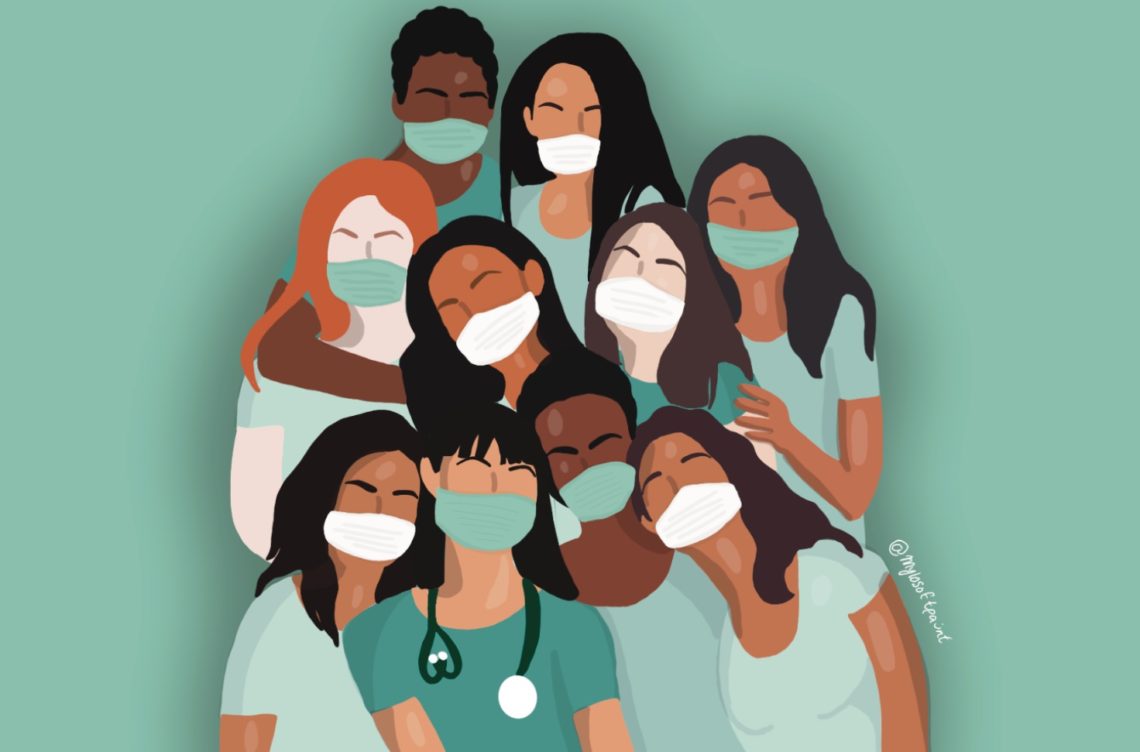Written By: Nardin Farag (she/her).
Edited By: Camille Zeitouni (she/her).
On May 25th 2020, George Floyd was murdered by a police officer in the United States. After witnessing this cruel and unjustified death, millions around the world arose and rallied against the systemic injustices the Black community faces today (1). Closer to home, I was hit with the gravity of the situation when realizing that my own medical education was, in the most insidious way, contributing to these injustices. In June 2020, the New England Journal of Medicine published a perspective piece titled How Medical Education is Missing the Bull’s Eye. This article had been written by a Black medical student, who described examples of how medical education was failing Black communities and the resultant gap in healthcare (2). One of the cited articles reveals that while the incidence of Lyme disease is higher in white people in the U.S., there are increased rates of late manifestations in African Americans (3). This gap is suggested to be caused by the failure to identify erythema migrans, a cutaneous early manifestation of the disease, in darker skin tone (3). Considering how multicultural of a city Montreal is, it was shocking to look back at the countless lectures I had in the previous year as a first-year medical student just to realize that only once or twice had we seen a picture of a non-Caucasian male, or had we been presented with values other than those applicable to the 70kg adult white man.
My own medical education was, in the most insidious way, contributing to these injustices.
The author from this article raises important questions: “How might this lack of representation indirectly contribute to the disparities we seek to address? And, what moral responsibility do medical schools have to ensure that students graduate with the tools and experience necessary to equitably treat these patient populations?” (2).
This brought to mind an example of how our curriculum is failing at addressing the higher incidences of Black maternal and infant mortality rates. While this disparity between Black and non-Black individuals can be partially attributed to the social determinants of health that encompass this population, many of the hardships that lead to these catastrophic outcomes are in fact due to unconscious bias (4). A report published in 2017 reveals that the rate of preeclampsia/eclampsia1 was 60% higher in Black individuals compared to white individuals (5). This was the sad reality for Simone Landrum, a Black woman and American citizen, who in a New York Times article talks about how her doctor didn’t take her concerns seriously when seeking care during her pregnancy. Those concerns included episodes of elevated blood pressure, headaches, swelling, and fatigue, which are all red flags for preeclampsia (6). Despite voicing them, the doctor would simply tell her to lie down and calm down – “It was like he threw [her] away” (6). This dismissal by her physician resulted in severe consequences of the abrupt separation of her placenta from the uterine wall, and resulted in the death of her daughter (6).
The reality is that even Black individuals who are more economically advantaged are at a higher risk of losing their child than white individuals with less money and lower levels of education (7). This can be explained by the growing evidence which shows that societal and systemic racism are a cause of physiological stress, and that it can also lead to dismissal of very legitimate concerns and symptoms (6). Reading Simone’s story, I wondered, was the physician not aware of the increased prevalence of preeclampsia and the increased risk of death and severe complications in Black people? Did they make assumptions about this patient from their unconscious bias? Do the health disparities seen in diverse Black communities start with their exclusion from the very foundations of medical education?
Do the health disparities seen in diverse Black communities start with their exclusion from the very foundations of medical education?
Moreover, in the United States, it is staggering to see that while racialized persons represent about ¼ of the total population, only about 6% of physicians are Latino, African American or Native (8). A survey conducted among medical students at Canadian medical schools in 2018 revealed that the respondents were less likely, in comparison to the Canadian Census population, to identify as Black (1.7% vs 6.4%) or Aboriginal (3.5% vs. 7.4%) (9). It has been shown in numerous studies that patients have greater trust and satisfaction when being cared for by physicians of the same race (8). In addition, students themselves who attend diverse schools feel more comfortable treating patients from different ethnicities (8). I hope it is clear by now that diverse populations in schools and diverse representation in learning materials is crucial.
In conclusion, diversity does not just stop at racial diversity – it comprises age, gender, ethnicity, physical disability, sexual orientation, religion, socioeconomic status, education, body size… (10). Therefore, beyond the responsibility that our medical school has in reflecting a student body that represents the diversity of the population it serves, they also need to ensure that students are trained in a way that will prepare them for the clinical setting. As current or future healthcare practitioners, it is imperative that we commence our role as patient advocates in medical school, to ensure that we are trained to treat every patient and reduce these health inequities. Therefore, I ask all present and future healthcare professionals: How will you play a role in making sure our patients are appropriately cared for, and how will you fight systemic racism within our institutions?
1Preeclampsia is defined as a new onset of elevated blood pressure after 20 weeks of gestation. Eclampsia is defined as preeclampsia accompanied by seizures, which may be followed by coma (5).
References:
1. Buchanan L, Bui Q, Patel JK. Black Lives Matter May Be the Largest Movement in U.S. History [Internet]. The New York Times. 2020 [cited 2021 Jan 29]. Available from: https://www.nytimes.com/interactive/2020/07/03/us/george-floyd-protests-crowd-size.html
2. Nolen L. How Medical Education Is Missing the Bull’s-eye. New England Journal of Medicine. 2020 Jun 25;382(26):2489–91.
3. Fix AD, Peña CA, Strickland GT. Racial Differences in Reported Lyme Disease Incidence [Internet]. Vol. 152. 2000. Available from: https://academic.oup.com/aje/article/152/8/756/126833
4. Matthew DB, Rodrigue E, Reeves R v. Time for Justice: Tackling Race Inequalities in Health and Housing [Internet]. Brookings. 2016 [cited 2021 Jan 30]. Available from: https://www.brookings.edu/research/time-for-justice-tackling-race-inequalities-in-health-and-housing/#_edn8
5. Fingar KR, Mabry-Hernandez I, Ngo-Metzger Q, Wolff T, Steiner CA, Elixhauser A. Delivery Hospitalizations Involving Preeclampsia and Eclampsia, 2005-2014 [Internet]. 2005. Available from: www.cdc.gov/reproductivehealth/maternalinfanthealth/pregnancy-complications-data.htm.
6. Villarosa L. Why America’s Black Mothers and Babies Are in a Life-or-Death Crisis: The Answer to the Disparity in Death Rates has Everything to do with the Lived Experience of Being a Black Woman in America [Internet]. The New York Times. 2018 [cited 2021 Jan 30]. Available from: https://www.nytimes.com/2018/04/11/magazine/black-mothers-babies-death-maternal-mortality.html?auth=login-email&login=email&fbclid=IwAR1gKV2NqH7dLvFAV_BcUiJi6ShNeHv-vbOAtatXcIEzb8xlE78aLX64yog
7. Reeves RV., Matthew DB. 6 Charts Showing Race Gaps within the American Middle Class [Internet]. Brookings. 2016 [cited 2021 Jan 30]. Available from: https://www.brookings.edu/blog/social-mobility-memos/2016/10/21/6-charts-showing-race-gaps-within-the-american-middle-class/
8. Paul B. Rothman. Diversity in Medicine has Measurable Benefits [Internet]. John Hopkins Medicine. 2016 [cited 2020 Dec 10]. Available from: https://www.hopkinsmedicine.org/news/articles/diversity-in-medicine-has-measurable-benefits#:~:text=Studies%20show%20that%20students%20trained,by%202.2%20minutes%2C%20on%20average.
9. Khan R, Apramian T, Kang JH, Gustafson J, Sibbald S. Demographic and Socioeconomic Characteristics of Canadian Medical Students: A Cross-Sectional Study. BMC Medical Education. 2020 May 12;20(1).
10. Verdonk P, Janczukowicz J. Editorial: Diversity in Medical Education. MedEdPublish. 2018;7(1).



